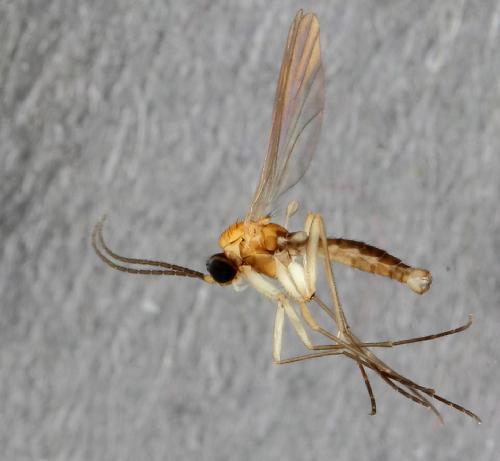Little did scientists Kai Heller and Björn Rulik expect to discover a new species in Germany's Alexander Koenig Museum's garden upon placing a malaise trap for testing purposes. Not only did an unknown and strikingly coloured gnat get caught, but it turned out to be a species, which showed to have much more in common with its relatives from New Zealand. Their study is published in the open access Biodiversity Data Journal (BDJ).
While the genus, which the new dark-winged fungus gnat species belongs to, likely originates from the Australasian region, it was so far represented by only three species in Europe. None of them, however, stands out with the contrasting colouration of the presently announced fourth one.
The new gnat, called Ctenosciara alexanderkoenigi after the German museum's founder, is described based on a single specimen caught in the framework of the German Barcode of Life Project (GBOL). Over three days, the scientists observed the flying insects getting caught in a malaise trap, placed among the predominantly non-native plants in the Alexander Koenig Museum's garden. This tent-like structure is designed to catch flying insects. Once they fly into its walls, they get funnelled into a collecting bottle.
 The new Ctenosciara alexanderkoenigi Heller & Rulik, 2016 dark-winged fungus gnat species. Credit: Zoologisches Forschungsmuseum Alexander Koenig / GBOL
The new Ctenosciara alexanderkoenigi Heller & Rulik, 2016 dark-winged fungus gnat species. Credit: Zoologisches Forschungsmuseum Alexander Koenig / GBOL
Upon noticing the beautiful striking colour of the fly, the two specialists were convinced they had just discovered a new to science species. Most of these flies are bright brownish, and the only other orange European dark-winged fungus gnat - almost uniformly orange. In contrast, the new species stands out with a mixture of reddish, black and yellowish-white hues. Based on the DNA-barcode match with New Zealand specimens, the authors concluded that the species must have arrived from the Australasian region in Europe quite recently.
"It is a rare occurrence, that a species from the opposite end of the world is represented by a single specimen only and it is not yet clear, whether Ctenosciara alexanderkoenigi has a permanent population in Germany or if it was only introduced casually with plants or soil," they explain. "Probably, the species was recently introduced from the Australasian Region. If it was a permanent member of the European fauna, a striking species like this would likely have been found earlier."
In conclusion, the scientists note that modern technologies such as the high quality photo documentation, established as a standard by the BOLD project, DNA barcodes assigned with BINs, as well as facilitated by speedy publishing, have largely aided taxonomists to build on the biodiversity knowledge.
"We believe that the rapid description of Ctenosciara alexanderkoenigi, coupled with the BDJ reviewing system, might be a robust and ground-breaking way to accelerate and stabilise taxonomy in the future," they finish their paper.
source: Pensoft Publishers